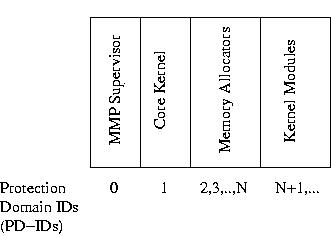
Figure 2 shows how the kernel address space can be split into multiple protection domains. The MMP memory supervisor domain (PD-ID 0) manages the memory permissions tables and provides an API to control memory permissions. In this section, we describe the MMP memory supervisor API by showing how it would be used during the boot of a modularized kernel.

At system reset, the processor starts running at the reset vector in PD-ID 0. The BIOS loads the memory supervisor into physical memory and transfers control to it, letting it know how much physical memory is in the machine. Early on, the supervisor establishes a handler for hardware permission faults.
The MMP hardware checks all processor memory accesses against the values stored in the current permissions table (except those made by domain 0). The MMP supervisor software can enforce additional memory usage policies because all calls for permissions manipulation are made via the supervisor. The supervisor will reject requests that violate its policy. Just because the supervisor exports an API does not mean that all created domains have permissions to call into it. As we will see, it is possible to construct a domain which does not have permission to call into the supervisor, forcing memory management to happen via the intermediary of the creating domain.
For example, the supervisor tracks ownership of memory regions. A domain obtains ownership after allocating a new memory region from the supervisor, or when another domain grants ownership of a region. Only the owner of a memory region may revoke permissions, or grant ownership to another domain.
Once initialized, the supervisor creates a new domain (PD-ID=1) to hold code and data for the core of the kernel. Protection domain creation is provided by the mmp_alloc_PD(user/kernel) supervisor call, which returns a PD-ID. The supervisor does not allow a user domain to create a kernel domain.
To start the kernel, the supervisor must first load the boot loader into PD 1. Initially, a PD has no permissions to access memory. In order for the boot loader to run, it will need execute permission on its code, read and write permissions on its data, a read-write stack, and possibly a read-write heap. Setting permissions is done by the mmp_set_perm(ptr, length, perm, PD-ID) routine. The memory supervisor uses the mmp_set_perm call to establish proper permissions for boot loader execution. The supervisor then performs a cross-domain call (described below) to transfer control to the boot loader which now runs in a protected kernel domain (PD-ID=1).
The boot loader wants to load the core kernel, and so needs to ask the memory supervisor for additional memory space. The mmp_alloc(n_bytes) supervisor function allocates a region of memory and returns a pointer (a variant of mmp_alloc allows a desired address placement to be supplied). The supervisor records PD-ID 1 as the owner of this memory region. The owner of a region can call mmp_free(ptr) to release a memory region back to the supervisor (mmp_free can also take an optional length parameter, allowing partial resources to be reclaimed).
Once the core kernel starts running, it can create child PDs to hold kernel modules. The core kernel will want to export permissions for portions of its address space to its child modules using the mmp_set_perm call, and it might also want to pass on ownership of memory regions to kernel modules, to allow them to manage the permissions of their children. The mmp_mem_chown(ptr, length, PD-ID) call passes ownership of a memory region to the protection domain given by the PD-ID parameter. Although a kernel module could be allowed to ask the supervisor for memory regions directly, usually the core kernel will manage memory usage of its modules. The core kernel can block kernel modules from calling the memory supervisor by not exporting call permission on the supervisor entry points to the kernel modules.
The mmp_set_perm call supports a transitive flag which, in addition to exporting permissions, also allows the receiving domain to transitively export permissions. This allows calling domains to either enforce a policy of only allowing a particular service domain (perhaps one containing cryptographically verified code) to implement a function, or allowing a service domain to subcontract work to other service domains. Transitive permissions are still distinct from ownership because only the owner can return memory to domain 0, and a domain that receives transitive permissions can not revoke permissions from a domain higher on the receiving chain.
Protection domains are created hierarchically, and they are destroyed hierarchically. The supervisor tracks the entire protection domain hierarchy, allowing parents to call mmp_free_PD(recursive) on their children. If the recursive flag is true, all of the deleted protection domain's children are also deleted. Otherwise, they are reparented to the closest surviving parent remaining in the tree.
One important special case for sharing data is global read-only access. MMP supports export of data to all protection domains read-only. When a piece of memory is exported globally, the supervisor adds the permissions to all existing permissions tables. It also tracks the global export in a table so it can add permissions for this globally exported memory to new protection domains as they are created.